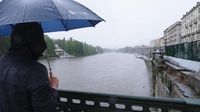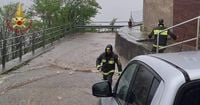As Easter approaches, many Germans are planning to travel, eager to soak up the sun in southern regions. However, this year, weather forecasts predict disappointment for many holidaymakers. Heavy snowfall and rain in the Alps, particularly in Switzerland, have caused significant traffic disruptions and chaos.
In the Swiss canton of Wallis, extreme weather has resulted in numerous road and railway closures. On Thursday, April 17, 2025, heavy snow and rain led to landslides and fallen trees, prompting authorities to close all schools in the region as a precaution. Many areas experienced temporary power outages, and the renowned ski resort of Zermatt was cut off from the outside world due to blocked transport routes. A representative from the local tourism office confirmed that transport connections were severely affected.
The Montana measuring station, located at approximately 1,400 meters, recorded 58 centimeters of fresh snow, the highest April measurement in nearly 100 years, according to MeteoSwiss. In even higher altitudes, such as the Great St. Bernard Pass, snowfall reached 100 centimeters. In response to the severe weather, the Wallis government declared a 'special situation' to facilitate coordination of emergency operations.
Residents were advised to stay at home, and tourists were urged to postpone trips to Wallis until Good Friday, April 18, 2025. The cantonal capital, Sitten, was closed to all vehicle and pedestrian traffic for safety reasons, and schools remained closed. Snow and rain also disrupted rail traffic in parts of the neighboring canton of Bern, with the Simplon Pass and the Great St. Bernard Pass closed due to heavy snowfall. The Simplon Tunnel and the Great St. Bernard Tunnel have been shut since Wednesday evening, April 16, 2025, for safety reasons.
Italy is also grappling with severe weather conditions. The Italian weather service reported heavy rain that turned into snow at elevations above 1,800 meters. Winds reached speeds of up to 110 kilometers per hour, causing flooding on the highway between Turin and Aosta, which was subsequently closed. Parks in Milan were shut down due to falling trees and branches, and in the Aosta Valley, residents were evacuated from homes and stables as rivers threatened to overflow.
In northern Italy, many rivers have burst their banks due to the heavy rainfall, particularly in the Piedmont region, which includes Turin as its capital. The Po River approached dangerous levels, leading to the closure of several areas near the river and numerous roads. Residents in some municipalities were advised to stay indoors as a precaution.
Tragically, a 92-year-old man drowned in the municipality of Monteu da Po, near Turin, after his home was surrounded by floodwaters. His body was recovered by rescue teams, highlighting the dire situation in the region.
The German Foreign Office has issued a travel and safety advisory for the affected areas, warning of high precipitation, thunderstorms, and snowfall above 1,500 meters until Easter Monday, April 21, 2025. Passes, tunnels, and roads may become impassable or closed due to the severe weather.
In over 100 municipalities in Piedmont, a red alert has been declared, with authorities fearing storm gusts, floods, and landslides. The situation is particularly critical in areas popular with tourists during the Easter holidays, such as South Tyrol, Lombardy, and Tuscany.
In Switzerland, heavy snowfall has also caused power outages, with the ski resort of Zermatt cut off from the outside world. Approximately 55 centimeters of new snow were recorded in Zermatt, while the Great St. Bernard Pass saw 100 centimeters. The Wallis government has closed roads and urged residents to stay home as trees have fallen due to the weight of the snow.
Weather warnings have also been issued in France, where the Météo-France weather service raised the avalanche warning level to the second-highest due to heavy snowfall in the Savoie region, which borders Italy. Around 4,000 households in France experienced temporary power outages, and several roads were closed due to fallen trees.
As the weather front moves eastward, it continues to affect southern Europe. In Spain, heavy rain has primarily impacted the inland and Atlantic coast, while the Mediterranean coast has seen more stable weather. In Portugal, temperatures during the first week of the Easter holidays have been pleasant, ranging from 10 degrees at night to 19 degrees during the day.
In the eastern Mediterranean, regions like Greece and Cyprus remain largely unaffected by the rain, with sunny Easter holidays anticipated, and temperatures in Cyprus could approach 30 degrees over the holiday weekend.
Back in Italy, the weather situation is expected to remain unstable, with further rain predicted on Easter Monday. Meteorologists warn that the current weather pattern is extraordinarily disturbed, leading to potentially life-threatening conditions, especially in mountainous areas and near rivers.
Travelers in the affected regions are advised to stay updated on weather conditions and to remain cautious, particularly in areas prone to flooding and landslides. The authorities recommend that people only leave their homes in emergencies and that tourists stay informed about the evolving weather situation.
As the situation develops, it is crucial for those planning to travel to Italy to remain vigilant and flexible with their plans, as the severe weather could lead to significant disruptions in travel and safety.







